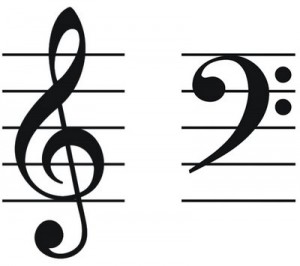When one listens to music, they likely do not imagine dots, lines and symbols in black and white on a piece of paper. However, in order for music to be interpreted by a conductor, musician or vocalist, they need to be represented in some readable fashion. Just as words are written on paper or typed in a computer, musical notes are composed on a set of five horizontal lines and four spaces, known as a staff. Depending on the instruments or vocal range associated with the musical piece, they are divided into two levels known as clefs. There are two separate clefs where notes may appear in sheet music, the treble clef and the bass clef.
The treble clef is where higher or brighter notes are composed, while the bass clef consists of lower rich tones. For the sake of simplicity and introduction, this lesson will focus only on the treble clef.
Notes in music are represented by a letter name from A to G. A full scale of notes actually consists of eight notes since the scale returns to the represented note of its foundation. In other words A, B, C, D, E, F, G with the eighth note completing and starting over with A. It is important to know however that even though the naming convention comes back to letter A after G, the tone is actually higher and does not mean the tone drops down to the first note of A in the scale. Any eight notes beginning respectively with a specific letter and returning to that letter up or down, make up a group of notes called an octave. The “oct” being derived for the Latin word “octo” meaning eight.
To listen to the musical piece below, click the play button [►] in the top left section of the window.
The short alphabetized order appears in an ascending fashion from bottom to top of the staff. The notes on the treble clef can be remembered by using a simple word and a phrase. The notes on the spaces from bottom to top are designated as F, A, C, E, or “FACE.” The notes on the lines are designated as E, G, B, D, F, which can be remembered by the phrase “Every Good Boy Does Fine.” You can also come up with other phrases that may help you remember, such as “Every Good Boy Deserves Fudge.”



